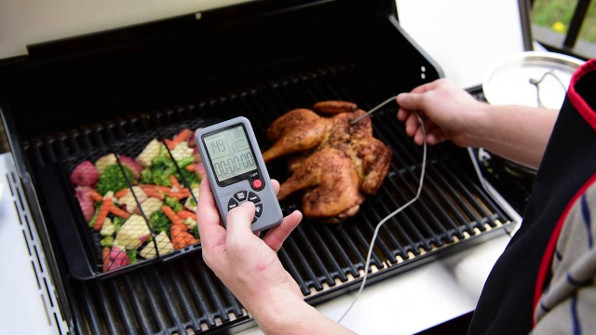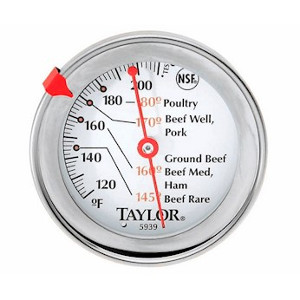Everyone who loves to cook should have a meat thermometer, and that goes double for Grilling enthusiasts. Not that you need two of them… You just need to use one, and use it properly, to ensure that your Grilled Meats are cooked to a safe temperature on the inside before serving…
 You can spend a few dollars on a basic meat Thermometer,
You can spend a few dollars on a basic meat Thermometer,
or a few hundred on a fancy digital one, as above…
Pro Chefs always use a meat thermometer to check the internal temperature of the foods they’re cooking, to ensue that they’re ‘done’. That means, not raw in the middle or overcooked to dry, leathery tastelessness.
Nowhere is a thermometer more useful than when grilling, especially of you’re cooking thick cuts of Beef or Whole Poultry or Fish. The most common error Grillers make concerning ‘doneness’ is serving Meats that are well done on the outside but still raw on the inside. This is particularly dangerous when you’re preparing Poultry and Fish, which can harbour Salmonella and other bugs.
Cooking evenly on the Grill…
We’ve already looked at one method that ensures even cooking for Poultry: Spatchcocking. This an old method that involves removing the backbone of the bird and flattening it out, ensuring even, all-round cooking even on a Grill with the lid open. With the lid closed, a Grill acts like an oven and circulates heat to all sides of a piece of Food. With the lid open, it acts like a camp fire, directing heat mainly to the bottom of the piece of Food.
Though many family Grillers use as much fuel as they can to generate the highest cooking temperatures they can, it’s best top cook large or thick pieces of Meat at lower temperatures for a longer time. This is a good way to avoid overcooking on the outside and under-cooking on the inside. On gas Grills, you can control the temperature like you would on a gas stove. On charcoal or wood-fired cookers, you can arrange the coals so that they are concentrated at one side of the Grill. This gives you two zones for cooking: Direct heat over the coals and indirect heat, away from the coals. Delicate foods like Fish and soft Veggies are best Grilled over indirect heat.
Using your thermometer…
Here are some simple guidelines for using and caring for your Meat thermometer:
- First, always measure the temperature of a piece of food by probing the thickest portion of it. If that part is done, so are the other, thinner parts.
- Unless you have an electronic, instant-reading model, leave the thermometer in the piece of food for at least a minute, to ensure you get an accurate reading.
- Make sure you clean your thermometer between uses to avoid cross-contamination.
- Don’t put your thermometer in in hot beverages or boiling waster. It’s not made for those temperatures and can be damaged.
- Never immerse the head pf your thermometer in water of any temperature. You’ll probably kill it.
Internal temperatures at which Meats can be considered safely cooked:
- Whole Poultry, Breasts or Thighs, or Ground Poultry: 165°F
- Hamburgers, Ground Beef: 160°F
- Beef roasts or steaks: Medium rare 145°F; Medium 160°F; Well-done 170°F
- Pork: 160°F
- Fish: 145°F
What about Sausages, you ask? Depends on whether they’re Pork or Beef! Just follow the guidelines above…
Grill safely this summer!
~ Maggie J.

